|
he National Association for Stock Car Auto
Racing (NASCAR) is the largest sanctioning body of
motorsports in the United States. The three largest racing
series sanctioned by NASCAR are the NEXTEL Cup Series, the Busch
Series and the Craftsman Truck Series. It also oversees seven
regional series and one local grassroots series. NASCAR
sanctions over 1,500 races at over 100 tracks in 38 states,
Canada, and Mexico. In 1996, 1997 and 1998 NASCAR also held
exhibition races in Japan.
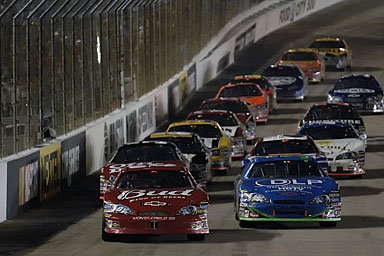 Beginning
as regional entertainment in the Southeastern U.S., NASCAR has
grown to become the second most popular professional sport in
terms of television ratings inside the U.S., ranking behind only
the National Football League. Internationally, NASCAR races are
broadcast in over 150 countries. It holds 17 of the top 20
attended sporting events in the U.S.1, and has 75 million fans
who purchase over $2 billion in annual licensed product sales.
These fans are considered the most brand-loyal in all of sports,
and as a result, Fortune 500 companies sponsor NASCAR more than
any other sport. Beginning
as regional entertainment in the Southeastern U.S., NASCAR has
grown to become the second most popular professional sport in
terms of television ratings inside the U.S., ranking behind only
the National Football League. Internationally, NASCAR races are
broadcast in over 150 countries. It holds 17 of the top 20
attended sporting events in the U.S.1, and has 75 million fans
who purchase over $2 billion in annual licensed product sales.
These fans are considered the most brand-loyal in all of sports,
and as a result, Fortune 500 companies sponsor NASCAR more than
any other sport.
NASCAR's headquarters are located in Daytona Beach, Florida,
although it also maintains offices in four North Carolina
cities: Charlotte, Mooresville, Concord and Conover as well as
New York City, Los Angeles, Arkansas, and international offices
in Mexico City, Mexico, and Toronto, Canada.
Early history
In the first decade of the 1900s, Daytona Beach became known as
the place to set world land speed records. The beach became a
mecca for racing enthusiasts. Fifteen records were set at the
beach between 1905 and 1935, when the Bonneville Salt Flats
became the premiere place to host land speed record attempts. In
1936 the course began hosting car racing events. Drivers raced a
1.5 to 2 mile stretch of beach as one straightaway, and
beachfront highway A1A as the other.
Other early race drivers were involved in bootlegging. The
runners would modify their cars in order to create a faster,
more maneuverable vehicle to evade the police. The next logical
step for the owners of these cars was to race them. These races
were popular entertainment in the rural South, and they are most
closely associated with the Wilkes County region of North
Carolina. Most races in those days were of modified cars, street
vehicles which were lightened and reinforced.
Mechanic William France Sr. moved to Daytona Beach from
Washington D.C. in 1935 to escape the Great Depression. He was
familiar with the history of the area from the land speed record
attempts. France entered the 1936 Daytona event, finishing
fifth. He took over running the course in 1938. He promoted a
few races before World War II.
France had the notion that people would enjoy watching
unmodified, "stock" cars race. Drivers were frequently
victimized by unscrupulous promoters who would leave events with
all the money before drivers were paid. In 1947, he decided this
racing would not grow without a formal sanctioning organization,
standardized rules, a regular schedule and an organized
championship. On December 14, 1947 France began talks with other
influential racers and promoters at the Ebony Bar at the
Streamline Hotel at Daytona Beach, Florida that ended with the
formation of NASCAR on February 21, 1948.
NASCAR was co-founded by France and Ed Otto on February 21,
1948. The sanctioning body hosted their first event at the
Daytona beach on February 15, 1948. Red Byron beat Marshall
Teague in the Modified division race. NASCAR had several
divisions in its early years. The first NASCAR "Strictly Stock"
race ever was held at the Charlotte Speedway (not the Charlotte
Motor Speedway) on June 19, 1949. France's Occoneechee Speedway
was one of the first two NASCAR t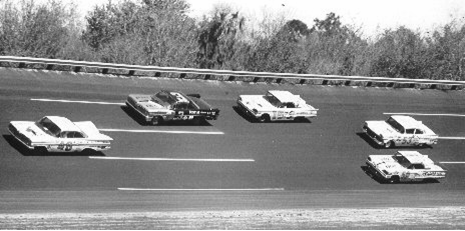 racks
to open and is the only track remaining from the inaugural 1949
season, although it is no longer raceworthy. The premiere track
that season was the Daytona Beach Road Course. racks
to open and is the only track remaining from the inaugural 1949
season, although it is no longer raceworthy. The premiere track
that season was the Daytona Beach Road Course.
Initially the cars were known as the Strictly Stock Division and
raced with virtually no modifications on the factory models.
This division was renamed "Grand National" after the first
season (in 1950). However, over a period of about a dozen years,
modifications for both safety and performance were allowed, and
by the mid-1960s the vehicles were purpose-built race cars with
a stock-appearing body.
Most races were on half-mile to 1-mile (800 to 1600 m) oval
tracks. However, the first "super speedway" was built in
Darlington, South Carolina, in 1950. This track, at 1.38 miles
(2.22 km), was wider, faster and higher-banked than the racers
had seen. Darlington was the premiere event of the series until
1959. Daytona International Speedway, a 2.5-mile (4 km)
high-banked track, opened in 1959, and became the icon of the
sport. The track was built on a swamp, so France took a huge
risk in building the track.
Growth of the sport
The sport began to attract more attention through the 1950s as
manufacturers realized the opportunity to promote sales through
racing. At various times Ford Motor Company (Ford and Mercury),
General Motors (Chevrolet and Pontiac), and Chrysler (Dodge,
Chrysler, and Plymouth) all supported factory teams, openly and
sometimes covertly when they pretended "not to be involved in
racing." The teams became full-time jobs for the top drivers and
owners. Although stock racing did not have much following
outside the Southeast, people like Lee Petty, Curtis Turner,
Fireball Roberts, Smokey Yunick, and Junior Johnson became well
known within the racing world.
Almost all the races were held in the southeastern U.S., because
the economics of traveling with racecars, parts, and mechanics
demanded it. Many of the venues were county fairgrounds or local
tracks that hosted local racing on Saturday night when the
touring stars were not in town. An exception was Riverside
Raceway, in Riverside, California; because of the travel
distances involved, it traditionally either started the Grand
National season or ended it. This was the only time NASCAR came
out west, until the opening of Ontario Motor Speedway in 1970,
and the only road course NASCAR ran on until the track closed in
1988.
Beginning of the modern era
NASCAR made major changes in its structure in the early 1970s.
The top series found sponsorship from R.J. Reynolds Tobacco
Company (RJR) (tobacco companies had been banned from television
advertising and were looking for a promotional outlet). The
"Winston Cup" (began in 1971) became the top competitive series,
with a new points system and some significant cash benefits to
competing for championship points. The next division down,
called Late Model Sportsman, gained the "Grand National" title
passed down from the top division and soon found a sponsor in
Busch Beer. In the mid-1970s some races began to get partial
television coverage, frequently on the ABC sports variety show,
Wide World of Sports.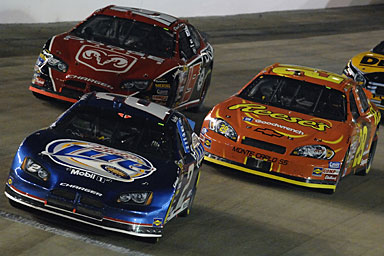
Finally, in 1979, the Daytona 500 became the first stock car
race that was nationally televised from flag to flag on CBS. The
leaders going into the last lap, Cale Yarborough and Donnie
Allison, wrecked on the backstretch while dicing for the lead,
and Richard Petty passed to win. Immediately, Yarborough,
Allison, and Allison's brother Bobby were engaged in a fistfight
on national television. This underlined the drama and emotion of
the sport and increased its broadcast marketability. Luckily for
NASCAR, the race coincided with a major snowstorm along the
United States' eastern seaboard, successfully introducing much
of the captive audience to the sport.
The beginning of the modern era, which NASCAR defines as 1972,
also brought a change in the competitive structure. The purse
awarded for championship points accumulated over the course of
the season began to be significant. Previously, drivers were
mostly concerned about winning individual races. Now, their
standing in championship points became an important factor.
The first NASCAR competition held outside of the U.S. was in
Canada, where on July 1, 1952, Buddy Shuman won a 200-lap race
on a half-mile (800 m) dirt track in Stamford Park, Ontario,
near Niagara Falls. On July 18, 1958, Richard Petty made his
premiership debut in a race at Toronto at the Canadian National
Exhibition Grounds. He completed 55 laps before crashing, while
father Lee won the 100-lap feature.
An exhbition race was held in 1988 in Australia, with Neil
Bonnett winning. In 1996, NASCAR went to Japan for Suzuka NASCAR
Thunder 100 at Suzuka Circuitland in Suzuka City on November 24,
1996. This exhibition (non-points) race was won by Rusty
Wallace. Two more exhibition races were held in Japan in 1997
and 1998, both races being won by Mike Skinner. On March 6, 2005
the first NASCAR points-paying race outside of the United States
since 1958 was held for the NASCAR Busch Series at the Autodromo
Hermanos Rodriguez racetrack in Mexico City. The winner of this
twisty road course event was defending series champion Martin
Truex, Jr.
NEXTEL Cup
NEXTEL Cup
The NASCAR NEXTEL Cup series is the sport's highest level of
professional competition, and consequently it is the most
popular and most profitable NASCAR series. The 2006 NEXTEL Cup
season consists of 36 races over 10 months, with well over $4
million in total prize money at stake at each race. Writers and
fans often use "Cup" to refer to the NEXTEL Cup series, and,
although ambiguous, the use of "NASCAR" as a synonym for the
NEXTEL Cup series is common.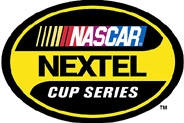
In 2004, NEXTEL took over sponsorship of the premier series from
Winston, formally (Winston Cup), renaming it the NEXTEL Cup
Series. In 2005 Tony Stewart became the first driver to win both
the Winston Cup and the NEXTEL Cup championship, although they
are the same championship.
Chase for the Cup
In 2004, NASCAR implemented a ten-race playoff system it called
the "Chase for the Cup". After 26 races, the top 10 drivers in
points (plus any driver within 400 points of the leader who may
be outside the top 10) are placed in the "Chase". Eligible
drivers' points are elevated to a level mathematically
unattainable by anyone outside this field. Points are also
bunched together in 5-point increments so the leader is 45
points ahead of 10th place. Race layouts remain the same and
points are scored the same way in the final 10 races. Whoever
leads in points after the 36th race is declared the NEXTEL Cup
champion.
This playoff system was implemented primarily to increase
television ratings during the college and National Football
League seasons, plus the Major League Baseball pennant race and
postseason as well as the outset of the NHL and NBA and to make
the points race more competitive. Previously, the champion may
have been decided before the last race (or even several races
before the end of the season) because it was mathematically
impossible for any other driver to gain enough points to
overcome him.
Drivers that are not in the "Chase" (not statistically able to
win the championship) still compete in the final ten races, with
the 11th place finisher receiving a $1 million bonus. Many
long-time fans and several veteran drivers have decried the new
format but sports media has given the last ten races increased
attention than in previous years.
Races and racetracks
NASCAR races are not conducted on identical tracks. Oval tracks
vary in length from 0.526 miles (847 m) (Martinsville Speedway)
to 2.66 miles (4.28 km) (Talladega Superspeedway). While some
tracks are ovals (Bristol Motor Speedway, Dover International
Speedway), many are tri-ovals (Kansas Speedway, Michigan
International Speedway). Other
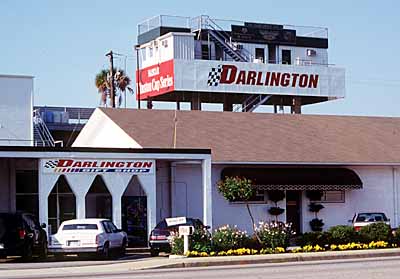 configurations
are quad-oval (Lowe's Motor Speedway, Atlanta Motor Speedway),
oval with unequal ends (Darlington Raceway), and triangular
(Pocono Raceway in Pennsylvania). Courses also differ in degree
of banking on the curves, with differences in degree of banking
and course length contributing to different top speeds on
various courses (New Hampshire International Speedway and
Phoenix International Raceway). Two courses (Infineon Raceway
and Watkins Glen International) are complex shaped road courses. configurations
are quad-oval (Lowe's Motor Speedway, Atlanta Motor Speedway),
oval with unequal ends (Darlington Raceway), and triangular
(Pocono Raceway in Pennsylvania). Courses also differ in degree
of banking on the curves, with differences in degree of banking
and course length contributing to different top speeds on
various courses (New Hampshire International Speedway and
Phoenix International Raceway). Two courses (Infineon Raceway
and Watkins Glen International) are complex shaped road courses.
Race speeds vary widely based on the track. The fastest track is
Talladega Superspeedway where the record race average speed is
188 mph (303 km/h) with the record qualifying lap of 212.809 mph
(342.483 km/h) set by Bill Elliott in 1988. The slowest tracks
are Infineon Raceway, a road course, with a record race average
speed of only 81 mph (130 km/h) and qualifying lap of 99 mph
(159 km/h); and Martinsville Speedway, a very short, nearly flat
"paper clip" oval, with a record race average speed of 82 mph
(132 km/h) and a qualifying lap of only 98 mph (156 km/h). The
average speed is figured out based upon the winner's lap speeds
throughout the entire races including laps spent under caution.
Generally, tracks with a length of less than one mile (1.6 km)
are referred to as "short tracks". Initially tracks of over one
mile were referred to as "superspeedways", but many NASCAR
venues now are 1.5 miles or 2 miles (2.4 or 3 km) in length.
Tracks on today's standards are now considered superspeedways if
they are over 2 miles (3 km) in length. Tracks between 1 and 2
miles in length are called "intermediate" tracks.
As a safety measure to reduce speeds at the two high-banked
superspeedways (Daytona and Talladega), a restrictor plate must
be placed between the carburetor and intake manifold to restrict
air and fuel flow and, therefore, power and hp. This has reduced
speeds at these tracks to the point that higher speeds are now
seen at some tracks where restrictor plates are not mandated,
specifically Atlanta Motor Speedway and Texas Motor Speedway.
While Atlanta is generally considered the fastest track,
restrictor plates are not mandated there, in 2004 and 2005
higher qualifying speeds were posted at Texas, earning it the
title of the circuit's fastest track. Unrestricted, NASCAR cars
produce over 750 horsepower (600 kW) and can run at speeds in
excess of 200 mph (miles per hour). Rusty Wallace completed a
2004 test for NASCAR at Talladega in which he used an
unrestricted motor to complete average lap speeds of 221 mph and
top speeds near 230 mph (Source: [1] NASCAR.com).
Present racecars
While the manufacturers and models of automobiles for Nextel Cup
and Busch Series racing are named for production cars (Dodge
Charger, Chevrolet Monte Carlo SS, and the Ford Fusion), the
similarities between Nextel Cup cars and actual production cars
are limited to some shaping of the nose and grill areas. On
January 23, 2006, it was announced that Toyota will enter the
Cup and Busch Series in 2007, fielding the Camry. In the
Craftsman Truck Series, the Chevrolet Silverado, the Dodge Ram
and the Ford F150, as well as the only non-American brand in
NASCAR, the Toyota Tundra, are used. NASCAR rules state the cars
or trucks must be manufactured in the US if they are to be used
in races. The Tundra and Camry qualify since both are
manufactured in the US.
The cars are high-powered, low-tech hot rods with a roll cage
chassis and thin sheet metal covering, and are powered by
carbureted engines with 4 speed manual transmissions. The
engines are limited to 355 in³ (5.8 L), with cast iron blocks,
one camshaft and a pushrod valvetrain. However, significant
engine development has allowed these engines to reach
exceedingly high levels of power with essentially 1950s
technology.
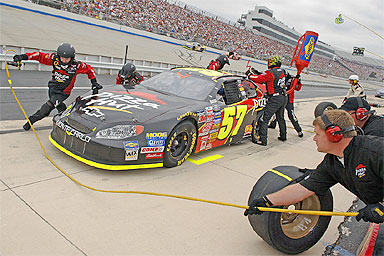 The
automobiles' suspension, brakes, and aerodynamic components are
also selected to tailor the cars to different racetracks. The
adjustment of front and rear aerodynamic downforce, spring
rates, rear track bar geometry, and brake proportioning are
critical to the cornering characteristics of the cars. A car
that is difficult to turn in a corner is said to be "tight",
causing the car to want to keep going up the track with the
wheel turned all the way left, while one that has a tendency to
slide the rear end out is said to be "loose", causing the back
end of the car to slide around which can result in the car
spinning out if the driver is not careful. Loose and tight can
be adjusted by increasing or decreasing the wedge and adding or
removing camber, the "footprint" of the tires during cornering.
These characteristics are also affected by tire stagger (tires
of different circumference at different positions on the car,
the right rear being largest to help effect left turns) and tire
pressure (softer being "grippier"). The
automobiles' suspension, brakes, and aerodynamic components are
also selected to tailor the cars to different racetracks. The
adjustment of front and rear aerodynamic downforce, spring
rates, rear track bar geometry, and brake proportioning are
critical to the cornering characteristics of the cars. A car
that is difficult to turn in a corner is said to be "tight",
causing the car to want to keep going up the track with the
wheel turned all the way left, while one that has a tendency to
slide the rear end out is said to be "loose", causing the back
end of the car to slide around which can result in the car
spinning out if the driver is not careful. Loose and tight can
be adjusted by increasing or decreasing the wedge and adding or
removing camber, the "footprint" of the tires during cornering.
These characteristics are also affected by tire stagger (tires
of different circumference at different positions on the car,
the right rear being largest to help effect left turns) and tire
pressure (softer being "grippier").
NASCAR will mandate changes during the season if one particular
car model becomes overly dominant. In fact almost all advantages
of using one car over another have been nullified. NASCAR used
to mandate stock or stock replacement hoods and decklids.
However, in recent years, NASCAR has begun to require cars to
conform to common body templates, regardless of make/model. This
is more in-line with recent NASCAR tradition, because none of
these stock cars have anything mechanically "stock" about them.
Car of Tomorrow
On January 12, 2006, NASCAR announced a universal car named "Car
of Tomorrow", to be used on Nextel Cup Series starting on 2007,
with all tracks switching to the new design by 2009[2]. Major
focus was put on safety, but the new design also reduced
dependence of aerodynamics and improved handling. Detachable
rear spoiler, a feature penalized since its use in Dodge Charger
Daytona and Plymouth Superbird in 1970, made a comeback[3].
Safety
Safety in racing has come a long way since the first green flag
dropped. Up until the last few years, NASCAR was heavily
criticized for its lack of focus on safety. Many safety
precautions were not mandatory, as they are in other racing
series, but only optional or recommended. NASCAR changed its
stance on this after the sport's most popular driver, Dale
Earnhardt was killed in a racing accident on the last lap of the
2001 Daytona 500.
The seats that the drivers sit in have evolved over the past few
years. Most of the seats found in the race cars wrap around the
driver's rib cage which provides some support during a crash,
spreading the load out over the entire rib cage instead of
letting it concentrate in a smaller area. Some of the newer
seats wrap around the driver's shoulders as well, which provides
better support because the shoulders are more durable than the
rib cage.
The seat belts in stock cars are very important. They are built
to be stronger than a normal seat belt. The seat belts used are
the five- or six-point harness, which is two straps coming down
over the driver's shoulders, two straps wrap around the waist,
and one or two come up between the legs. Since a string of
accidents in 2000 and 2001 that killed Adam Petty, Kenny Irwin,
Tony Roper and Dale Earnhardt (plus several other drivers in
minor circuits) under similar circumstances, NASCAR has made it
mandatory for the drivers to wear the HANS Device (Head And Neck
Support) to restrict head movement and subsequent neck injury
during a crash. Though NASCAR allowed another system (Hutchens)
in the past, since 2005, HANS is the only head and neck
restraint device allowed for use. It is a semi-hard collar made
of carbon fiber and Kevlar, and it is held onto the upper body
by a harness worn by the driver. Two flexible tethers on the
collar are attached to the helmet to reduce the head's tendency
to snap forward or to the side during a wreck.
In 1994, NASCAR introduced roof flaps to the car, which are
designed to keep cars from getting airborne and possibly
flipping down the track. If the speed of the car is high enough,
it will generate enough lift to pick up the car if it spins
backwards. To prevent this, NASCAR officials developed a set of
flaps that are recessed into pockets on the roof of the car.
When a car is turned around, and is going fast enough, the flaps
come up and disrupt the airflow over the roof, eliminating most
of the lift. The roof flaps generally keep the cars on the
ground as they spin, although it is not guaranteed.
Beginning in the early 2000s, most tracks have installed softer
walls and barriers along the track, called SAFER (Steel And Foam
Energy Reduction) Barriers. Soft walls are typically built of
aluminum and styrofoam; materials that can absorb the impact of
a car at high speeds, as opposed to a concrete wall which
absorbs little-to-none of the impact. There are four types of
softer walls and barriers:
-
Cellofoam — This is an encapsulated
polystyrene barrier — a block of plastic foam encased in
polyethylene.
-
Polyethylene Energy Dissipation System
(PEDS) — This system uses small polyethylene cylinders
inserted inside larger ones. Designers of PEDS believe the
system increases the wall's ability to withstand crashes of
heavy race cars.
-
Impact Protection System (IPS) — This
inner piece of the wall is then wrapped in a rubber casing.
Holes are drilled in the concrete wall and cables are used to
tie the segments to it.
-
Compression barriers — This idea is
to place cushioning materials, such as tires, against the
concrete wall, and then cover those cushions with a smooth
surface that would give when impacted, and then pop back out
to its previous shape once the impact is over.
Pit road safety has become the latest focus of
NASCAR officials in recent years. At each track there are
different speeds the cars are required to travel at (the speed
depends on the size of the track and the size of pit road,
generally 35 mph (60 km/h) on short tracks and road courses, 45
mph (70 km/h) on intermediate tracks and 55 mph (90 km/h) on
superspeedways). NASCAR has placed a new electronic scoring
system in use as of 2005 to monitor the speeds of cars on pit
road by measuring the time it takes to get from checkpoint to
checkpoint. As none of the cars are equipped with speedometers,
the cars in prerace warm up laps are driven around the track at
the pit road speed following the pace car so the drivers can
mark on the tachometer the telemetry (term referring to the
Revolutions Per Minute it takes to travel at the "speed limit")
for the day. The tachometer then "guides" the speed of the car
down pit road.
Over the wall pit members are now required to wear helmets after
a string of members were injured and some open wheel series many
members were ran over. In addition to the helmets, all members
are required to wear full fire suits and gloves while the
refueller must wear a fire apron as well as the suit. Tire
changers must also wear safety glasses to prevent eye injuries
from lug nuts thrown off the car.
As with changes to car models, NASCAR will institute new rules
during a season if it deems it necessary to enhance safety.
North Carolina race shops
North Carolina has been deemed "NASCAR Valley" as 73% of all
American motorsports employees work in North Carolina (this
includes other motorsports series such as CART and ARCA). The
majority of NASCAR teams are located in or near the
Charlotte-metro area. Cities in North Carolina that are home to
NASCAR teams include: Charlotte, Wilkesboro, Mooresville,
Concord, Statesville, Huntersville, Welcome, Kernersville,
Randleman, Greensboro, High Point, Harrisburg, and Kannapolis.
Specifically, 82% of Nextel Cup teams, 72% of Busch Series
teams, and 55% of Craftsman Truck Series teams are based in
North Carolina. The majority of NASCAR Nextel Cup and Busch
Series drivers maintain their primary residences near Charlotte.
Other NASCAR racing series
In addition to the three main series, NASCAR operates several
other racing circuits.
Many local racetracks across the United States and Canada run
under the Dodge Weekly Series banner, where local drivers are
compared against each other in a formula where the best local
track champion of the nation, as based on a formula, wins the
Dodge Weekly Series National Championship.
NASCAR also sanctions three regional racing divisions: The
Whelen Modified Tour, which races open wheel "modified" cars in
Northern and Southern divisions; the AutoZone Elite Division,
which races late-model cars which are lighter and less powerful
than Nextel Cup cars, split into four divisions, Northwest,
Southwest, Southeast, and Midwest; and the Grand National
Division, which races in the Busch East (Formerly Busch North)
and the AutoZone West Series. Grand National cars are similar to
Busch Series cars, although they are less powerful.
In 2003, NASCAR standardized rules for its AutoZone Elite and
Grand National divisions regional touring series as to permit
cars in one series to race against cars in another series in the
same division. The top 15 (Grand National) or 10 (AutoZone
Elite) in each series will race in a one-race playoff, called
the NASCAR Toyota All-Star Showdown, to determine the annual
AutoZone Elite and Grand National champions. This event has been
hosted at Irwindale Speedway in California since its inception.
Many drivers move up through the series before reaching the
NEXTEL Cup series. In 2002, over 9,000 drivers had licenses from
NASCAR to race at all levels.
The winners of the Dodge Weekly Series National Championship,
the four AutoZone Elite Divisions, the two Whelen Modified and
Grand National Divisions, and the three national series are
invited to New York City in December to participate in Champions
Week ceremonies which conclude with the annual awards banquet at
the Waldorf-Astoria Hotel.
Broadcast coverage
Before the 2001 NASCAR TV deal, each track discussed the TV
rights with each network on their own. From the 1970s to the end
of 2000, races usually alternated from one network to another
from week to week with CBS and the Daytona 500 and then moving
on to the other networks over the rest of the schedule. These
networks were CBS, ABC, NBC, ESPN, TBS, and TNN. NBC did not
start covering a race every year until 1999 and only covered one
race each season, at Homestead-Miami Speedway. At the end of
1999 and beginning of 2000, NASCAR began to develop its own TV
deal. Continuing their relationship with Turner and NBC, NASCAR
added FOX and their family of networks in 2001 leaving CBS, ABC,
ESPN, and TNN out of the deal. Ted Turner decided to move the
coverage from TBS over to sister network TNT following the 2000
season.
In the United States, television broadcast rights are split
between FOX/FX and NBC/TNT, with FOX/FX airing the first half of
the season (from the second race of the season, currently at
California Speedway, to the last race before the Pepsi 400 at
Daytona, currently at Infineon Raceway) the (Dodge/Save-Mart
350K) and NBC/TNT airing the second half of the season from the
race at Chicagoland Speedway to the season finale (the Ford 400)
at Homestead-Miami Speedway. The networks alternate coverage of
the first and most famous race of the season, the Daytona 500,
with Fox getting the odd years and NBC the even ones. For
balance, the opposite network will air Daytona's July race, the
Pepsi 400. The current television contract was signed for eight
years for FOX/FX and six years for NBC/TNT and is valued at $2.4
billion (US) [4]. FOX-owned Speed Channel carries the entire
Craftsman Truck Series schedule.
On December 7, 2005, NASCAR signed a new eight-year, $4.48
billion deal [5] with FOX and the Fox-owned SPEED Channel,
Disney-owned ABC, ESPN and ESPN2, along with TNT that will begin
in 2007. The rights were split up as such:
-
FOX will carry the Daytona 500 every year
and the 12 points races after that, as well as the Budweiser
Shootout and two Craftsman Truck Series races (including
Daytona, and one TBD).
-
TNT will carry the next 6 Nextel Cup races
including the Pepsi 400 at Daytona International Speedway.
-
ABC and ESPN will carry the final 17 Nextel
Cup races, with ABC carrying the Allstate 400 at The Brickyard
and the entire Chase for the Cup, and the entire Busch Series
will be split between ABC, ESPN, and ESPN2 (which will carry
the majority of the races).
-
SPEED Channel will carry the Gatorade Duel's
races and the All-Star Challenge, as well as the entire
Craftsman Truck Series season, except for the two races
carried by FOX.
Audio coverage
Audio coverage of all Nextel Cup, Busch Series, and the
Craftsman Truck Series races is available in the United States
on both satellite radio and regular over-the-air broadcast radio
on both the AM and FM bands. XM Radio currently holds the
exclusive satellite radio broadcast rights for all NASCAR
coverage through the end of the 2006 season. On February 23,
2005, NASCAR awarded the satellite radio contract to XM Radio's
primary competitor Sirius Satellite Radio for exclusive
satellite radio rights to the 2007 through 2011 racing seasons
in exchange for $107 million dollars.[6]. Motor Racing Network
(MRN), a subsidiary of International Speedway Corporation (ISC),
holds the over-the-air broadcast radio rights of 25 Nextel Cup
races, all truck races, and 26 Busch Series races, as well as
the Budweiser Shootout, the Gatorade Duel and Nextel All-Star
Challenge. Performance Racing Network, a subsidiary of Speedway
Motorsports, airs ten Cup races and nine Busch races. The
Indianapolis Motor Speedway's network carries the Allstate 400
at The Brickyard in co-operation with PRN. All broadcasts are
also available (for a fee) via the web at NASCAR.com [7].
Perceptions of NASCAR
While the sport has grown tremendously, NASCAR still faces bias
from many people who do not enjoy the sport. Critics claim that
NASCAR should not be considered a 'sport', as the essence of the
competition is the control of a machine, and not the human body.
However, this does not turn away most people from its appeal to
watch and enjoy, and in any case, the criticism is one that
applies to any form of auto racing and is not exclusive to
NASCAR. Many fans claim that NASCAR is a very physically
demanding activity, more so than sports such as golf, since it
requires extreme concentration while driving a vehicle at speeds
near 200 miles per hour with temperatures in the car well over
155 degrees fahrenheit.
Fan Demographics
It is sometimes perceived that most NASCAR fans are rednecks
because of the sport's Southern heritage; this stereotype is, at
best, inaccurate. According to NASCAR, about 10% of NASCAR fans
are African-American, which is a slightly smaller percentage of
Blacks than in the general population. This compares to the NFL,
where Black NFL fans represent about 11.7% of the total NFL
base. The percentage of Black NASCAR fans has grown by 86% since
1999. There have also been some attempts by NASCAR to bring in
more African American fans into the seats, and drivers into the
races. About 40% of fans are female and their numbers are
rising. About 75% have attended college and more than 25% own
their own homes. About 36% of NASCAR fans make more than $50,000
a year. Finally, NASCAR fans are evenly distributed across the
country. For example, 20% of NASCAR fans live in the Northeast
U.S.; this is in line with the general population—20% of the
U.S. population lives in the Northeast. While the largest base
of NASCAR fans live in the Southern U.S., only 38% of the NASCAR
fans live in the South. Again, this is in line with the general
population—35% of the population lives in the South.
|


